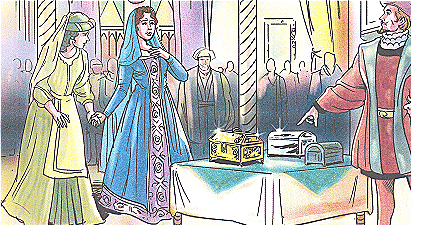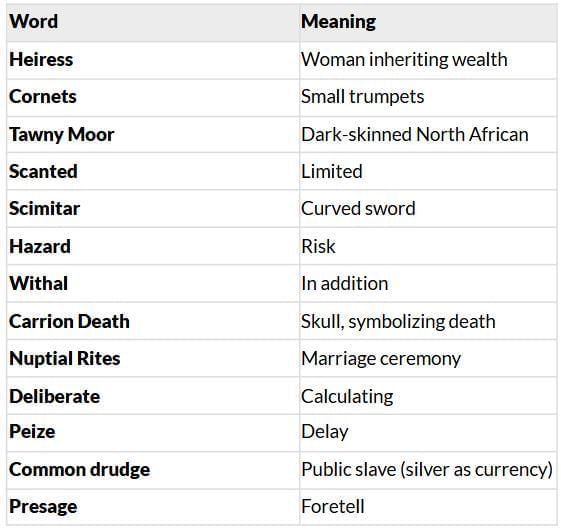The Three Caskets Chapter Notes | Gul Mohar Class 8: Book Solutions, Summaries & Worksheets PDF Download
| Table of contents |

|
| About the Author |

|
| Detailed Summary |

|
| Moral/Message |

|
| Character Sketches |

|
| Vocabulary Table |

|
About the Author
William Shakespeare (1564–1616), known as the "Bard of Avon," is considered the greatest English playwright and poet. He wrote 37 plays and 154 sonnets, exploring human emotions through comedy, tragedy, and history. The Merchant of Venice (1596–1598), a comedy, examines love, justice, and prejudice, with the casket test as a key plot device.
Detailed Summary
The excerpt from "The Merchant of Venice" focuses on the casket test, a challenge devised by Portia’s late father to ensure that only a worthy suitor, who values Portia for her true self rather than her wealth, can marry her. The test involves three caskets—gold, silver, and lead—each bearing an inscription. The suitor who chooses the casket containing Portia’s portrait wins her hand in marriage, but those who choose incorrectly must swear never to marry and leave Belmont immediately. The scene showcases three suitors: the Prince of Morocco, the Prince of Arragon, and Bassanio, each approaching the test with distinct reasoning and outcomes.
Prince of Morocco (Act II, Scene VII):
The Prince of Morocco, a proud and valiant warrior, asks Portia not to judge him by his dark complexion, emphasizing his bravery and appeal. He examines the caskets and is drawn to the gold casket, which reads, “Who chooseth me shall gain what many men desire.” Assuming this refers to Portia, whom many desire, he chooses it. However, he finds a skull and a scroll inside, warning that “all that glisters is not gold,” indicating his choice was driven by superficial allure rather than wisdom. Disappointed, he accepts his failure and leaves.
Prince of Arragon (Act II, Scene IX):
The Prince of Arragon, arrogant and self-assured, dismisses the lead casket as unworthy and the gold casket as appealing to the “fool multitude” who judge by appearances. He chooses the silver casket, inscribed with “Who chooseth me shall get as much as he deserves,” believing his noble status entitles him to Portia. Inside, he finds a portrait of a “blinking idiot” and a scroll mocking his overconfidence, revealing his error in assuming his worth without humility. He leaves, vowing to honor his oath.
Bassanio (Act III, Scene II):
Bassanio, a Venetian and Portia’s true love, approaches the caskets with caution and insight. Portia, who loves him, urges him to delay his choice, fearing his failure would separate them. Bassanio reflects on the deceptive nature of appearances, comparing gold to Midas’s curse and silver to common currency. He chooses the lead casket, which reads, “Who chooseth me must give and hazard all he hath,” valuing its simplicity and the risk it demands. Inside, he finds Portia’s portrait and a scroll praising his wisdom for not judging by outward show. Overjoyed, Portia gives herself and her wealth to Bassanio, sealing their bond with a ring, which he must never part with, lest their love be ruined.
Moral/Message
The casket test teaches that true value lies beyond appearances, and wisdom and humility surpass pride and greed. Morocco and Arragon fail due to superficial judgment, while Bassanio succeeds through love and discernment, showing that inner worth and risk-taking for love prevail.
Character Sketches
- Portia: Intelligent, virtuous heiress bound by her father’s will. She loves Bassanio but remains honorable, refusing to break her oath. Her wit and compassion shine, especially in her joy at Bassanio’s success.
- Prince of Morocco: Proud warrior, sensitive about his complexion. His choice of gold reflects superficiality, but he accepts defeat honorably.
- Prince of Arragon: Haughty and self-assured, he chooses silver, assuming his worth. His failure reveals his lack of humility.
- Bassanio: Thoughtful and loving, he chooses lead, showing wisdom and genuine affection for Portia, proving his worthiness.
- Nerissa: Portia’s loyal, witty attendant, supporting her mistress and hoping for Bassanio’s success.
Vocabulary Table

|
32 videos|62 docs|17 tests
|
FAQs on The Three Caskets Chapter Notes - Gul Mohar Class 8: Book Solutions, Summaries & Worksheets
| 1. What is the central theme of "The Three Caskets"? |  |
| 2. Who are the main characters in "The Three Caskets" and what roles do they play? |  |
| 3. What moral lesson can be drawn from the story of "The Three Caskets"? |  |
| 4. How does the choice of casket symbolize the characters' personalities in "The Three Caskets"? |  |
| 5. What vocabulary terms are significant in understanding "The Three Caskets" and its themes? |  |



















